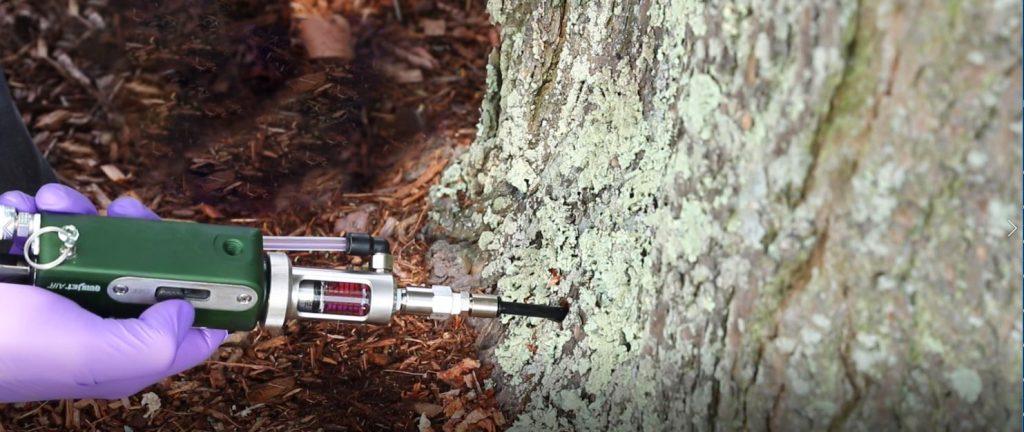Conifers that retain their foliage also will retain systemically applied chemistries, such as imidacloprid. Hemlocks retain their foliage for 3 to 6 years. Researchers have evaluated the longevity of imidacloprid in the twig and needles. They found that imidacloprid and one of its metabolites, olefin persisted within the tissues for up to 5 years. This is pretty interesting because in deciduous trees, much of the imidacloprid does accumulate in foliage, but is then shed with leaf fall to be broken down by microbial activity.
Some Things to Think About Before Injecting
Remember that when treating hemlock by injection, the risk to off-target organisms is reduced for a number of reasons.
- The active ingredient is put directly into the tree rather than in the soil where the roots of nearby flowering plants could take it up.
- Hemlock is wind pollinated, not bee pollinated.
- Imidacloprid moves through the xylem sap, meaning that it moves to the sites of greatest evapo-transpiration; and in hemlock it is the needles, and not the reproductive structures.
- The systemic affects the insects feeding directly on the trees tissues.
Hemlock woolly adelgid feeds in the xylem ray parenchyma cells. Parenchyma cells are the living tissues within the xylem. It is a network of radial and axial tissues that form a reticulated network. These cells store and move sugars; is it not a little wonder why HWA feeds within these cells? Interestingly, imidacloprid moves in the xylem (non-living cells) and is stored in the parenchyma (living cells), just where HWA feed!
Systemic injection is very targeted to the pest feeding on the tree. Applications that last for 4 or 5 years are advantageous when you wish to treat trees in a forest setting. One does not have to repeat treatments every year: you can treat trees effectively on a 5-year rotation. This allows you to begin to manage a number (a forest?) of trees efficiently.
So, Where Do You Start?

Simply, start with a survey of high value trees. High value trees are those that provide ecological services (nesting for birds, shading streams for trout, holding soil in place, etc.) or they may have value because of how old they are. Old growth hemlock have been recorded as old as 600 and 900 years; it is (was) our redwood of the east! At minimum, trees that ought to be considered for treatment may simply be seed trees, those trees that will become the seed bank once HWA burns through the forest.
New outbreaks have been recently reported outside the contiguous hemlock region – in Michigan and in Nova Scotia. Though the long-term plan is to introduce predatory insects that feed on adelgids, this will take time to establish, some estimate as much as 10 years. Published researches suggest that HWA can kill hemlock in as little as 4 years, but may take 10 years. In that time, 60 to 80% of the hemlock may be lost. So, an integrated approach is needed, and tree injection using IMA-jet (5% imidacloprid) may help to save not only hemlock, but important parts of a unique forest ecosystem.
